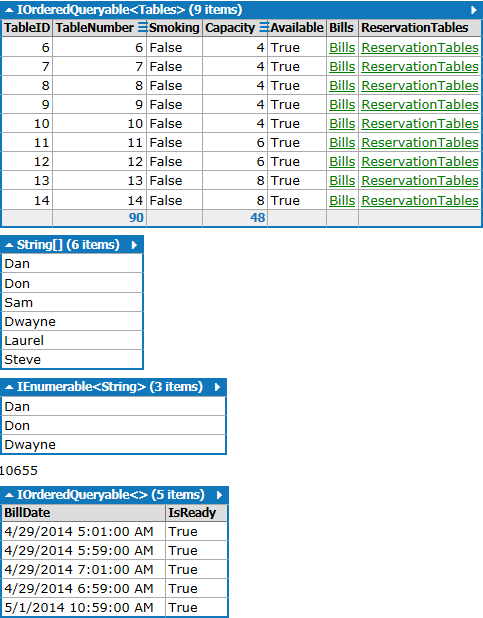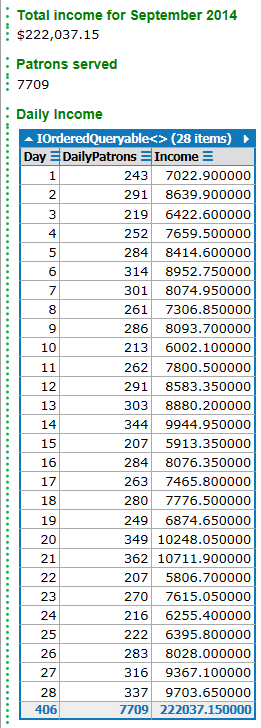# C# Statements
When using the statement context in LinqPad, you write complete lines of code as though you were writing in the body of a method. To output results in LinqPad, you need to use the .Dump() extension method on the objects you want to output.
# A Series of Examples
This example of C# Statements in LinqPad include both LINQ Queries on database tables and simple arrays.
/* Example 1: Querying data from eRestaurant */
var result = from row in Tables
where row.Capacity > 3
select row;
// The following line won't work in your VS project....
result.Dump(); // the .Dump() method is an extension method in LinqPad - it's not in .NET
/* Example 2: Query a simple array of strings */
string[] names = {"Dan", "Don", "Sam", "Dwayne", "Laurel", "Steve"};
names.Dump();
var shortList = from person in names
where person.StartsWith("D")
select person;
shortList.Dump();
/* Example 3: Find the most recent Bill and its total */
// Get all the bills that have been placed
var allBills = from receipt in Bills
where receipt.OrderPlaced.HasValue
select new // declaring an "anonymous type" on-the-fly
{ // using an initializer list to set the properties
BillDate = receipt.BillDate,
IsReady = receipt.OrderReady
};
allBills.Count().Dump(); // show the count of items
allBills.Take(5).Dump(); // show the first 5 bills

# Income and Business Volume Summary
LinqPad allows you to set a title for your output by sending a string into the .Dump() method.
The following query shows the total income for the previous month and the number of patrons served.
// Get the following from the Bills table for the past month:
// BillDate, ID, people served, total potentially billable (BillItem.Quantity * BillItem.UnitCost),
// and actual amount billed
// Then display the total income for the month and the number of patrons served.
var billsThisMonth = from item in Bills
where item.PaidStatus
&& item.BillDate.Month == DateTime.Today.Month -1
&& item.BillDate.Year == DateTime.Today.Year
orderby item.BillDate descending
select new
{
BillDate = item.BillDate,
BillId = item.BillID,
NumberInParty = item.NumberInParty,
TotalBillable = item.BillItems.Sum (bi => bi.Quantity * bi.UnitCost),
ActualBillTotal = item.BillItems.Sum (bi => bi.Quantity * bi.SalePrice)
};
var title = string.Format("Total income for {0} {1}",DateTime.Today.AddMonths(-1).ToString("MMMM"),DateTime.Today.Year);
billsThisMonth.Sum (tm => tm.ActualBillTotal).ToString("C").Dump(title, true);
billsThisMonth.Sum (tm => tm.NumberInParty).Dump("Patrons served", true);
# Daily Income Report
With LinqPad, you can incrementally build your queries in multiple statements.
// Get the following from the Bills table for the current month:
// BillDate, ID, people served, total potentially billable (BillItem.Quantity * BillItem.UnitCost),
// and actual amount billed
// Then display the total income for the month and the number of patrons served.
var billsThisMonth = from item in Bills
where item.PaidStatus
&& item.BillDate.Month == DateTime.Today.Month - 1
&& item.BillDate.Year == DateTime.Today.Year
orderby item.BillDate descending
select new
{
BillDate = item.BillDate,
BillId = item.BillID,
NumberInParty = item.NumberInParty,
TotalBillable = item.BillItems.Sum (bi => bi.Quantity * bi.UnitCost),
ActualBillTotal = item.BillItems.Sum (bi => bi.Quantity * bi.SalePrice)
};
var title = string.Format("Total income for {0} {1}",DateTime.Today.AddMonths(-1).ToString("MMMM"),DateTime.Today.Year);
billsThisMonth.Sum (tm => tm.ActualBillTotal).ToString("C").Dump(title, true);
billsThisMonth.Sum (tm => tm.NumberInParty).Dump("Patrons served", true);
var report = from item in billsThisMonth
group item by item.BillDate.Day into dailySummary
select new
{
Day = dailySummary.Key,
DailyPatrons = dailySummary.Sum(s => s.NumberInParty),
Income = dailySummary.Sum (s => s.ActualBillTotal)
};
report.OrderBy (r => r.Day).Dump("Daily Income");
// extra diagnostics/details
// billsThisMonth.Take(5).Dump("Top Five bills in collection");
// Bills.Single(b => b.BillID == 21194).BillItems.Dump("Bill Items on Bill # 21194");
